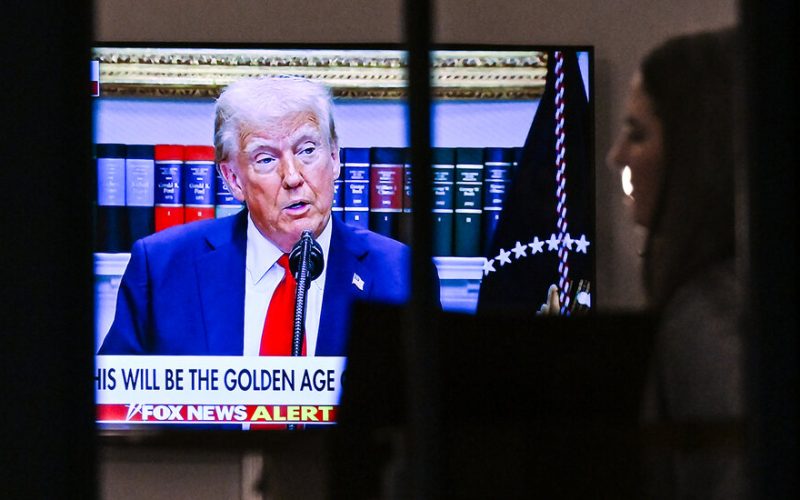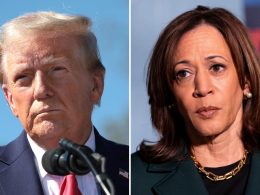President Trump has been back in office for two and a half days, and the cascade of news hasn’t stopped.
With a stroke of his Sharpie, the president sought to end birthright citizenship. He allowed defendants in the Jan. 6, 2021, riot at the Capitol to walk free. He withdrew from the World Health Organization and the Paris Climate Agreement. He has begun a crackdown on immigration.
He is already changing the country, and the nation’s politics are going to change with it — though we don’t yet know how.
As the second Trump era begins, I want to take a step back from the news to lay out the major political story lines that my colleagues and I will be watching over the next year.
Here they are:
Is the public behind Trump’s expansive agenda?
Trump has claimed an electoral mandate, despite his relatively narrow margin of victory, and the early days of his presidency have shown just how aggressively he intends to enact his agenda, testing the limits of his power in the process. In a country that’s used to — and tired of — deadlock in Washington, this could be good politics. But some of his sweeping actions, including giving clemency to nearly 1,600 Jan. 6 defendants or his effort to end birthright citizenship, are downright unpopular. We will be watching what that means for his new coalition.
It’s still the economy, stupid.
Speaking of Trump’s coalition: The president assembled the support of a younger and more diverse coalition than Republicans before him, in part by promising that a second term would bring economic prosperity that working-class Americans feel eluded them after the pandemic. Yet the president’s plans to impose steep new tariffs and deport scores of undocumented immigrants could actually raise prices, rather than lower them. Will that further stoke the nation’s economic discontent, and whom will voters blame?
The new politics of immigration.
Trump believes that it was immigration — not the economy — that won him the election, and his crackdown has begun. In 2017, Democrats fought his immigration policies at every turn, but their approach is different this time. On Monday, 12 Senate Democrats — most from purple states like Nevada or Georgia — voted with Republicans to pass the Laken Riley Act, which increases deportations for undocumented migrants charged with crimes. We’ll pay close attention to the way Democrats talk about this issue in the coming years — particularly those on the ballot in 2026.
And the rollout of Trump’s policies will test how far in his direction the country’s views on immigration have really shifted, particularly when it comes to children, families and legal immigrants. On this issue, the details matter.
The Democrats’ search for a response to Trump — and a path back to power.
The Democratic Party is locked out of power in the White House and Congress. It has no obvious leader. There is no shared diagnosis of what went wrong in November. And the only thing Democrats know for sure right now is that their resistance-era Trump playbook of opposition and impeachments hasn’t worked — which might explain their muted response to the first days of his administration. We’ll be looking closely at the new messages Democrats try, both in Washington and out in the country, as they aim to wrestle back some of their power in 2026 — and at which messengers seem to gain an audience.
Can a G.O.P. showing cracks squelch dissent?
When Trump took office in 2017, there were Trump Republicans and the old guard. Now, Trump’s party has remade itself in his image — but it’s not exactly one big happy family. Republicans are divided over tariffs, immigration, abortion, Trump’s embrace of tech billionaires and his plans for tax cuts that would expand the nation’s deficit. The question, though, is whether Republicans are actually willing to imperil his agenda by defecting from his legislative priorities or voting down his nominees. Trump’s allies have already targeted Republicans who indicated even a sliver of willingness to do so with coordinated and well-funded attacks.
What Trump 2.0 means for life in America.
It’s too early to know yet how the new administration will reshape American life, but we do know what Trump has promised: Enormous immigration raids. An end to diversity, equity and inclusion efforts. Tax cuts. The elimination of whole government agencies, like the Department of Education, that play significant but low-profile roles in communities across the country. In an age of deep political polarization, those changes might not do much to change the way people think about politics. But we’ll be listening to see if they do.
Is the country — and the world — getting redder?
Were Republicans’ gains in November — which extended from Trump’s popular-vote win all the way down to their gains in key statehouses — a post-pandemic cyclical reaction to economic discontent, or a sign of a bigger shift around the globe? It wasn’t just the United States where liberals struggled. Over the last year, far-right parties have made gains in countries like France, Germany and Austria, while Canada’s Justin Trudeau — long a symbol of international resistance to Trump — has bowed to an angry electorate and agreed to step down.
That is one of the key questions to explore this year, and it’s one best answered out in the country, not in Washington. There are a series of elections this year that can offer us some insight, but we’ll also be paying attention to the policies gaining traction as both parties test out their messages ahead of the 2026 midterms.
2028.
Too soon? I get it. You just got through one all-consuming election cycle, and you don’t want to think about the next one. But the people who want power in America definitely are. No one has made any obvious moves just yet, but the under-the-radar jockeying could begin in a matter of months.
Trump is a one-term president, according to the Constitution, and Republicans are quietly speculating that the field of would-be successors could be large, even if Vice President JD Vance currently looks like Trump’s most obvious heir, with his every move scrutinized through that lens. The race to be the Democrats’ next nominee is wide open. We have no idea whose political fortunes will rise or fall by 2028 — remember when Jeb Bush seemed like the one to beat in 2016? — but we know that what happens over the next year will shape the political battles to come.








